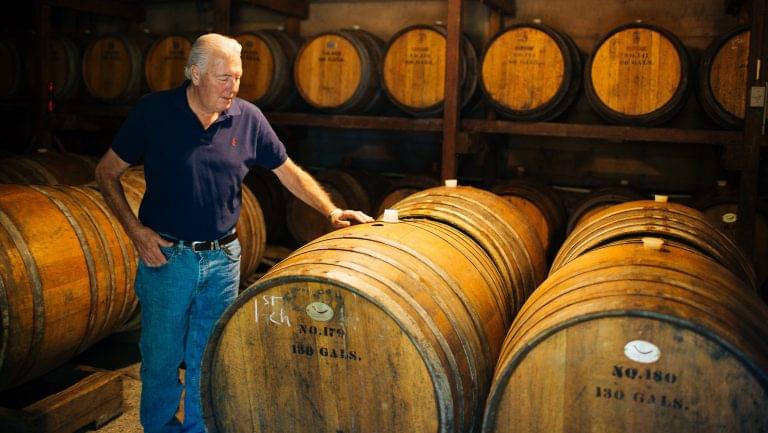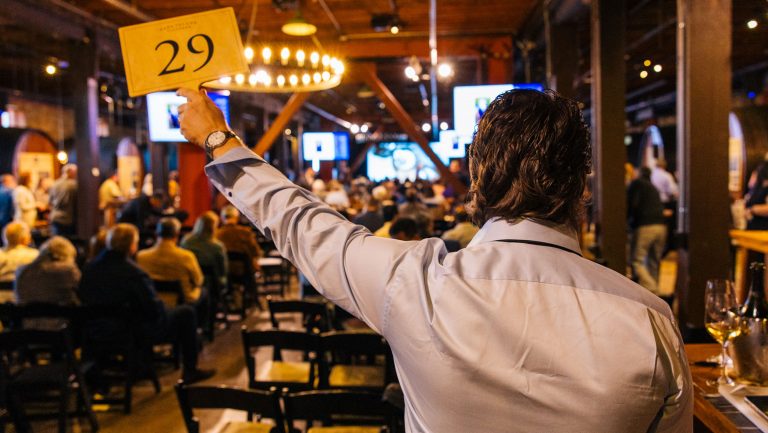In a high-end winery, nothing says “financial solvency” like a palatial barrel cellar: stone walls, recessed lighting, and row upon row of identical barriques, purchased new from a tonnelier for $1,000 or more a pop. (Bonus points for painting each barrel’s middle section burgundy so as to avoid any unsightly bunghole stains.)
But walk into the barrel room at Stony Hill Vineyard in California’s Napa Valley, and you’ll see barriques and puncheons that look quite well worn, their iron hoops gently rusted. This cooperage isn’t even remotely new—the barrels at Stony Hill range from one to four decades in age.
And that’s the way Stony Hill Vineyard president Sarah McCrea likes it.

Don’t miss the latest drinks industry news and insights. Sign up for our award-winning newsletters and get insider intel, resources, and trends delivered to your inbox every week.
“We want to make vineyard-driven and age-worthy Chardonnays that stand alongside the best in the world,” says McCrea, whose Chardonnays start at $48 a bottle at retail, “and [we] believe that neutral barrels work best for the style we’re hoping to achieve. We are lucky to have a following that appreciates the transparency of our wines. Historically, Chablis was aged in old wooden feuillette barrels, which don’t impart any oak flavors.”
Most quality-driven modern wineries keep barrels for only three to five years. By the fourth or fifth fill, the vessel is totally neutral, imparting no oak characteristics to the wine. For producers whose style includes a certain percentage of new oak, it’s essential to continually rotate fresh barrels into the cellar and move older cooperage out.
But many in the industry replace their barrels every five years for another reason: fear of contamination. At a trade show recently, I asked a French tonnelier rep how his barrels fare after the age of five. He stared at me in horror and exclaimed, “It’s just not sanitary!”
“We have methods to keep a barrel clean and sanitary well after the five-year point,” counters Ed Morris, the associate winemaker at Ron Rubin Winery in the Russian River Valley.
Morris, who was a professional cooper before getting into winemaking, says that barrels can last much, much longer than is commonly believed. “Oak is an incredibly durable material,” he says. “It’s the process of drying out and shrinking, then hydrating and swelling, that will damage the structure of the wood.” To get longevity out of their barrels, Morris advises, winemakers should essentially treat them like wine: Store them inside at a stable temperature and humidity level to prevent the wood from shrinking and expanding. “Both [temperature and humidity],” he explains, “contribute to the breakdown of the wood itself by weakening the fibrous material which holds it together.
According to Morris, empty barrels require a routine maintenance protocol, such as burning a sulfur candle or releasing compressed sulfur dioxide gas into the barrel every 30 days, to prevent microbial growth, and steam cleaning or washing the insides of the barrels (with ozonated water) every 60 days. “Both steam and ozone,” he says, “will kill a large portion of the microbial population inside the barrel.” Many winemakers, however, find that much less maintenance is necessary if they simply keep their barrels filled with wine at all times. The alcohol has bactericidal effects and the moisture creates a barrier that protects the surface of the wood from fungus.
Indeed, Spanish and Portuguese wineries keep the same barrels hard at work in solera systems not just for decades but for centuries. At Bodega El Maestro Sierra in Jerez, Spain, visitors can see barrels dating to 1830 and signed by the winery’s founder. And while the increased alcohol of fortified wines is helpful in keeping bacteria at bay, table wines, too, can age in very, very old oak. At Clos Cibonne in Provence, century-old foudres are thought to be essential to building the unique character of the Tradition rosé. “These barrels have the memory of 100 years of wines going into them,” explains André Tamers, the founder and president at De Maison Selections, which imports El Maestro Sierra and Clos Cibonne.
“In Piemonte, they never put Barolo in new wood. Their lesser wine, like a Barbera, would go in a new botte,” says Blake Murdock, the managing director for wholesale at The Rare Wine Co. In the Loire, he continues, Domaine Huet uses 80-year-old demi-muids that “are all shaggy and moldy on the outside because those caves are very humid. But the wines are delightful.” Visitors to the Huet cellar might be appalled to see the shag, but “the outsides don’t really matter.”
“It doesn’t matter what a barrel looks like on the outside,” agrees Andy Erickson, the winemaker at Mayacamas in Napa. He admits, however, that he hasn’t always felt this way. He was slightly uneasy when, five years ago, he took charge of the winery’s barrel room, in a building that dates to 1889, and found that he was expected to use oak vessels up to 80 years old. He feels more confident now that he has a steam generator: “Steaming the barrels keeps them very clean and kills the yeast and bacteria in there.” Other experts I spoke with agreed that steam cleaning is extremely effective. They also advised filling unused cooperage with salt water for sanitary storage, and burning sulfur candles in empty barrels before refilling them.
Switching to newer barrels wasn’t an option for Erickson, because Mayacamas is known for its distinctive old-guard style. “We think in terms of Barolo rather than Bordeaux,” he explains. “The young wines start out with a very rustic character. With age, they soften, with the fruit staying forward.”
The American wineries that are using old barrels tend to be standard-bearers for traditionalism. Mayacamas Vineyards, as mentioned above, dates to 1889. Stony Hill Vineyard was founded in 1952 and has followed the same barrel program since. And at The Eyrie Vineyards, the oldest Pinot Noir producer in Oregon’s Willamette Valley, the barrels date to 1970. Jason Lett, Eyrie’s winemaker, likes the fact that the pores in the wood seal up over years of cellaring, rendering his oldest cooperage far less oxidative than his newer oak. Lett keeps his barrels in constant use, racking one vintage while barreling the next. He says, “It’s just a question of keeping them wet.”

Dispatch
Sign up for our award-winning newsletter
Don’t miss the latest drinks industry news and insights—delivered to your inbox every week.
Katherine Cole is the author of four books on wine, including Rosé All Day. She is also the executive producer and host of The Four Top, a James Beard Award–winning food-and-beverage podcast on NPR One. She is currently working on a fifth book, Sparkling Wine Anytime (Abrams), to be published in Fall 2020.







